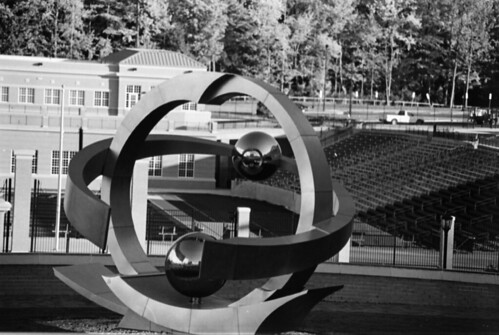As a graduate student it is recommended that I take 9 credit hours, a maximum of 12 is allowed. At the current time I am interested in or have been offered 21 hours.
| Spring 2013 |
| Code |
Course |
School |
HR |
GR |
| CSLG7600 |
Sexual Orientation Diversity in Clinical Practice |
UNC Charlotte |
3 |
|
| SOCY6652 |
Issues in Social Research |
UNC Charlotte |
3 |
|
| SOCY6635 |
The Social Context of Mental Health |
UNC Charlotte |
3 |
|
| SOCY6651 |
Social Theory |
UNC Charlotte |
3 |
|
| PHIL6060 |
IS: Existentialism |
UNC Charlotte |
3 |
|
| SOCY6090 |
Field Experience in Qualitative Research |
UNC Charlotte |
3 |
|
| ITIS6010 |
Tangible Design Studio |
UNC Charlotte |
3 |
|
| Total Hours: |
21.0 |
|
| GPA: |
NA |
When I originally inquired and was authorized to take CSGL7600 I was not in the Sociology degree program and therefore had spare hours to burn, potentially toward a Master of Arts in Liberal Studies. Since things have changed, I will likely not pursue this course any longer. The area still interests me, but I do not feel that it will add anything to my current program or help me develop any skills for upcoming projects (thesis, etc).
Existentialism was a course that I so badly wanted to take when I still had free elective space for Spring, but now I’m not sure, I don’t think it will work out for this particular semester. I fought with administrative politics to get authorization to do the course and now it seems as though it just won’t work out.
Social Theory and Issues in Social Research are required courses for my program. I would love to slip out of one of them to make room for other courses, but I will have to discuss that with my graduate coordinator.
The remainder are courses that I will have to fight between to determine which courses I ultimately will take during the spring. Social Context of Mental Health I would love to do, especially since I am not taking the counseling course. The Field Experience course counts as a research credit and is actually a course I am looking forward to taking, it should be very hands on. Tangible Design Studio is the course that has lead to me applying to the Master of Science in Information Technology. If by some chance I am not admitted to the program this course looses priority on my list, but I will likely still try to take it as a course for my Cognitive Science certificate.
The course descriptions appear below:
Sexual Orientation Diversity in Clinical Practice [CSLG7600]
The course considers the experience of being gay, lesbian, bisexual or transgendered in our society. Theoretical understandings of sexual orientation are covered, as well as the impact of societal prejudice on gay, lesbian, bisexual and transgendered individuals and their communities. The experience of diversity with such communities is discussed, especially racial/ethnic diversity. Exploration of individual values combines with an emphasis on clinical practice to make this course relevant both personally and professionally. — 3 hours
Planned
Issues in Social Research [SOCY6652]
Lisa S. Walker
Examination of epistemology of social research; assumptions and methods of specific research strategies; ethical and policy issues of applied and academic research — 3 hours
Planned
The Social Context of Mental Health [SOCY6635]
This course draws upon contributions from the field of psychiatry, psychology, social work, and anthropology. The focus is on mental health and illness it is social context, with an emphasis on the relationship between social structure and mental health/disorder. We will examine the social factors which shape psychiatric diagnosis, the effects of socio-demographic variables on mental health, and the role of social support and stress for different groups. The course also examines the organization, delivery, and evaluation of mental health services, and mental health care policy. — 3 hours
Planned
Social Theory [SOCY6651]
Dr. Murray Webster
Analysis of contemporary social theories, with emphasis on their implications for planned change. — 3 hours
Planned
IS: Existentialism [PHIL6060]
Existentialist tradition in philosophy and literature including such issues as: authenticity, absurdity and the meaning of life, freedom and morality, anguish, death, and atheism. — 3 hours
Planned
Field Experience in Qualitative Research [SOCY6090]
Field Experience in Qualitative Research is designed to familiarize students with key theoretical issues, research design decisions, logistical and practical considerations of qualitative research through hands-on research activities related to the Roots of STEM project. The Roots of STEM Project is a National Science Foundation funded study of the pathways to a science, technology, engineering or mathematics major among college students attending the 16 campuses of the UNC system. The course is designed as part of the qualitative phase of the Roots Project, during which researchers will employ semi-structured, in-depth interviews to obtain the answers to the research questions of interest that were generated, in part, by the quantitative findings from the first phase of the project. — 3 hours
Planned
Tangible Design Studio [ITIS6010]
Tangible computing incorporates gesture, grasping, and the use of physical objects as integral parts of interaction design. Comparing graphic user interfaces with tangible user interfaces shows that this change in perception and action changes cognition – providing opportunities for designing digital environments that have a dramatically different impact on how we think and interact. In this course you will learn about different approaches to tangible computing such as siftables, AR toolkit, the Samsung Pixelsense tabletop computer, and Microsoft Kinect. The course will be taught as a design studio: 1 hour per week in a classroom setting and 2 hours per week in a studio with tangible devices that you will learn to program. The assessment for the course is a design project, including design reports and a prototype implementation. Assumed background: programming course or experience, ITIS3130 or equivalent — 3 hours
Planned



